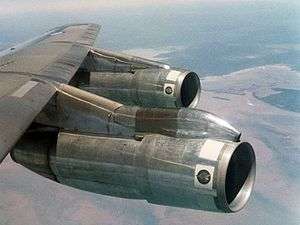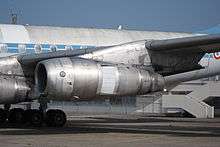Pratt & Whitney JT3D
| JT3D/TF33 | |
|---|---|
 | |
| JT3D-3B on a Royal Australian Air Force Boeing 707 | |
| Type | Turbofan |
| Manufacturer | Pratt & Whitney |
| First run | 1958 |
| Major applications | B-52H Stratofortress Boeing 707 C-141 Starlifter Douglas DC-8 |
| Number built | ca. 8,600 |
| Developed from | Pratt & Whitney J57/JT3C |
The Pratt & Whitney JT3D is an early turbofan aircraft engine derived from the Pratt & Whitney JT3C turbojet. It was first run in 1958 and was first flown in 1959 under a B-45 Tornado test aircraft. Over 8,000 JT3Ds were produced between 1959 and 1985. Most JT3D engines still in service today are used on military aircraft, where the engine is referred to by its USAF designation of TF33.
Design and development
Aware of the competition from the Rolls-Royce Conway turbofan, Pratt&Whitney decided to develop the JT3D turbofan from the JT3C turbojet for later deliveries of the Boeing 707 and the Douglas DC-8, then nearing entry into service. A 2-stage fan replaced the first 3 stages of the 9-stage JT3C LP compressor. On the LP turbine, the second stage was enlarged and a third stage added.
Unlike GE with the CJ805-23, Pratt & Whitney had not undertaken any transonic fan research prior to designing the JT3D, so they were unable to incorporate a single stage unit into the specification.[1] Instead P&W designed a 2-stage unit based on some research they had done to support the J91 nuclear turbojet.
Nevertheless, the overall P&W engine design was quite an elegant solution to produce a turbofan to compete with the Rolls-Royce Conway in a very short timescale. Indeed, 55 years later, the basic architecture of the JT3D can still be seen in modern large American civil turbofans, such as the GE90, PW4000, etc..
On the Boeing 707 the JT3D fan nacelle was relatively short, whereas the Douglas DC-8 installation had a full length fan cowl. Pratt & Whitney provided a kit whereby JT3C's could be converted to the JT3D standard in an overhaul shop.[2]
In 1959, important orders for the engine were the Boeing 707-120B and Boeing 720B when American Airlines ordered one 707 powered by JT3D turbofans and KLM ordered a JT3D powered Douglas DC-8. The earlier 707s had been powered by the turbojet JT3C and the improved efficiency of the turbofan soon attracted the airlines. A JT3D powered 707-123B and 720-023B (the suffix B was to indicate a turbofan powered aircraft) entered service with American Airlines on the same day, March 12, 1961.
The Boeing KC-135 Stratotankers were all originally powered by turbojet engines. With the demise of many airline 707s the United States Air Force took the opportunity to buy the surplus airframes and use the engines to re-engine the KC-135As used by the Air National Guard and reserve squadrons with the civilian JT3D (designated TF33-PW-102). Over 150 aircraft were modified and the former KC-135A were re-designated the KC-135E.[3]
After long service for both airlines and air forces the number of JT3D powered aircraft is steadily decreasing. 135 KC-135s use the JT3D while 354 were fitted with CFM International CFM56 engines which provide greater thrust and increased operational flexibility due to their lower noise footprint. The noise of the JT3D is one of the reasons NATO has debated re-engining their E-3 Sentry AWACS fleet, since the aircraft are subject to restrictions that modern-engined aircraft are not. Operational flexibility would be further increased due to the ability of higher power engines to increase the ceiling of the aircraft, extending the horizon for radar surveillance; for instance, RAF, French and Saudi E-3s routinely fly higher than NATO/USAF counterparts.
Another well known aircraft which is fitted with the JT3D (in TF33 form) is the Boeing B-52H Stratofortress. The 'H' model of the B-52 was the only production variant of the famous bomber to be fitted with turbofan engines, and the only model remaining in US Air Force service. It is expected to remain as a mainstay of the USAF heavy bomber fleet until at least 2040.
Variants
- JT3D-1
- 17,000 lbf (75.62 kN) thrust civil version, (Water injection optional)[4]
- JT3D-2
- (TF33-P-3) 17,000 lbf (75.62 kN)[4]
- JT3D-3
- 18,000 lbf (80.07 kN), (Water injection optional)[4]
- JT3D-3A
- (TF33-P-5) 18,000 lbf (80.07 kN)[4]
- JT3D-3B
- 18,000 lbf (80.07 kN) thrust civil version
- JT3D-5A
- (TF33-P-7) 18,000 lbf (80.07 kN), (Water injection optional)[4]
- JT3D-8A
- (TF33-P-7) 18,000 lbf (80.07 kN), (Water injection optional)[4]
- JT3D-7
- 19,000 lbf (84.52 kN) thrust civil version
- JT3D-15
- 22,500 lbf (100.08 kN) thrust civil version for the unbuilt 707-820
- TF33-P-3
- 17,000 lbf (75.62 kN) thrust for the Boeing B-52H Stratofortress[4]
- TF33-P-5
- 18,000 lbf (80.07 kN) thrust for the Boeing KC-135 Stratotanker[4]
- TF33-P-7
- 21,000 lbf (93.41 kN) thrust for the Lockheed C-141 Starlifter[4]
- TF33-P-11
- 16,000 lbf (71.17 kN) thrust for the Martin RB-57F Canberra
Aircraft applications

- Civilian (JT3D)
- Military (TF33)
- B-52 Stratofortress
- Boeing C-18
- C-135B Stratolifter
- E-3 Sentry
- E-8 Joint STARS
- KC-135E Stratotanker (JT3Ds from surplus civil 707 airliners)
- VC-137B/C Stratoliner
- C-141 Starlifter
- Martin RB-57F
Specifications (JT3D-1)
General characteristics
- Type: Turbofan
- Length: ≈138 in (3505 mm)flange-to-flange
- Diameter: ≈ 51.57 in (1310 mm) fan tip
- Dry weight: ≈4361 lb (1978kg) bare engine
Components
- Compressor: Axial flow, 2-stage fan, 6-stage IP compressor and 7-stage HP compressor
- Combustors: cannular, 8 flame tubes
- Turbine: Axial flow, single stage HP turbine and 3-stage LP turbine
Performance
- Maximum thrust: 17,000 lbf (76 kN) Take-off (flat-rated to ISA); partial thrust restoration with water injection
- Overall pressure ratio: ≈12.5:1; bypass ratio 1.42:1
- Air mass flow: 432 lb/s (196 kg/s)
- Turbine inlet temperature: ≈1150 K @Take-off, SLS, ISA
- Specific fuel consumption: ≈0.78 lb/(lbf·h) (22 g/(kN·s)) @ 4000 lbf thrust, M 0.82, 35000 ft, ISA
- Thrust-to-weight ratio: 3.9 bare engine
Specifications (TF33-P-7)
General characteristics
- Type: Turbofan
- Length: 142 in (3607 mm)
- Diameter: 54 in (1371.6 mm)
- Dry weight: 4650 lb (2109 kg)
Components
- Compressor: Axial flow, 2-stage fan, 7-stage IP compressor and 7-stage HP compressor
- Combustors: cannular, 8 flame tubes
- Turbine: Axial flow, single stage HP turbine and 3-stage LP turbine
Performance
- Maximum thrust: 21,000 lbf (93 kN) Maximum Rating, SLS, ISA
- Overall pressure ratio: ≈16:1
- Air mass flow: 498 lb/s (226 kg/s)
- Turbine inlet temperature: ≈1227K
- Specific fuel consumption: 0.56 lb/(lbf·h) (16 g/(kN·s)) Maximum Rating, SLS, ISA
- Thrust-to-weight ratio: 4.516
See also
- Related development
- Related lists
References
- ↑ Smith, George E.; Mindell, David A. (2000), "The Emergence of the Turbofan Engine", Atmospheric Flight in the Twentieth Century, Kluwer Academic Publishers, pp. 107–155
- ↑ based on article in Flight magazine 19 December 1958
- ↑ Tony Pither, The Boeing 707 720 and C-135, Air-Britain (Historians), 1998, ISBN 0-85130-236-X
- 1 2 3 4 5 6 7 8 9 Taylor, John W.R. FRHistS. ARAeS (1962). Jane's All the World's Aircraft 1962-63. London: Sampson, Low, Marston & Co Ltd.
- ↑ http://www.aircraftenginedesign.com/TableB2.html
- Taylor, John W.R. FRHistS. ARAeS (1962). Jane's All the World's Aircraft 1962-63. London: Sampson, Low, Marston & Co Ltd.
External links
| Wikimedia Commons has media related to Pratt & Whitney TF33. |